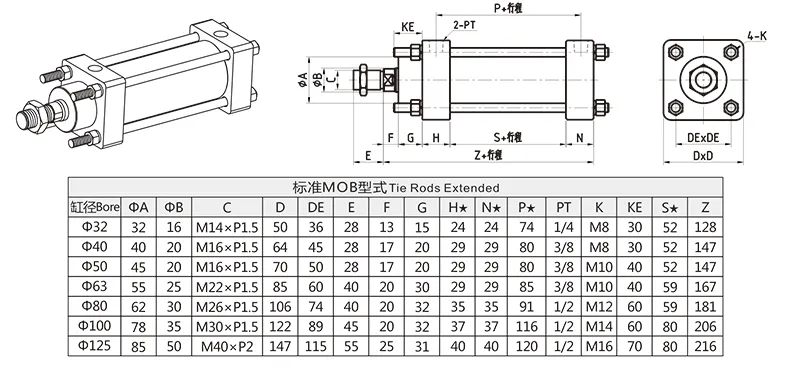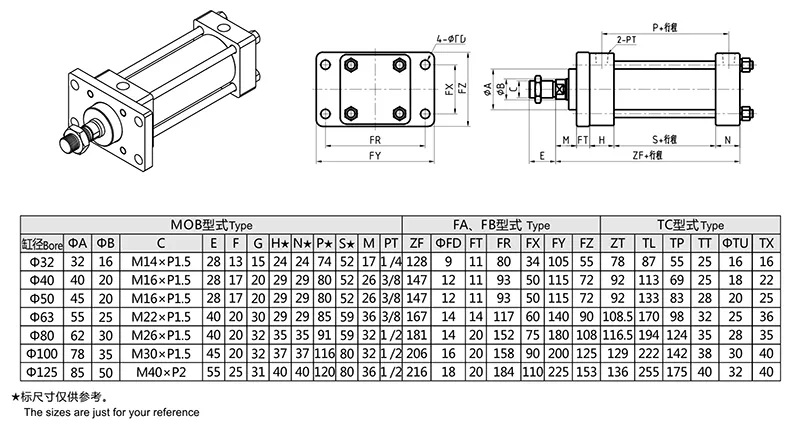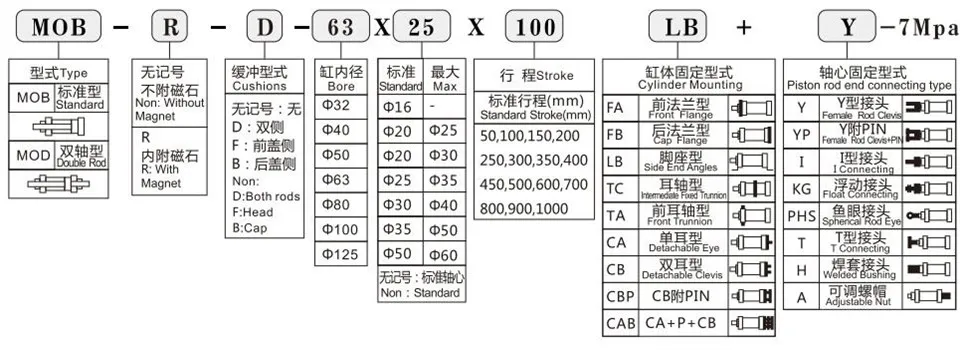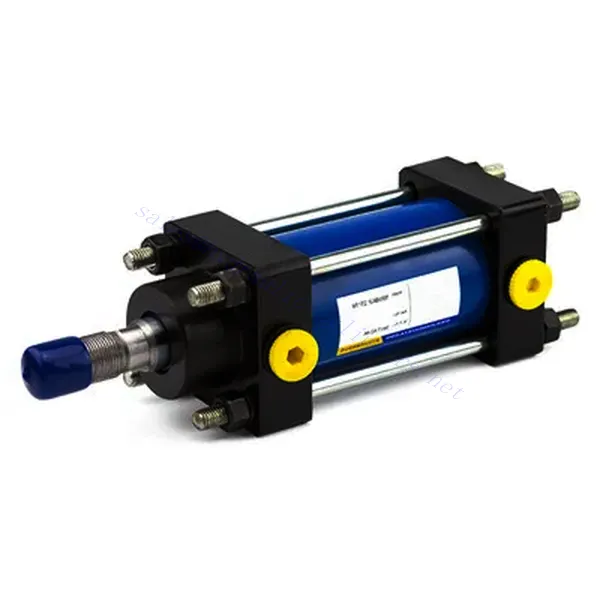MOB Type Light Rod Hydraulic Cylinder
In qualità di uno dei produttori, fornitori ed esportatori di prodotti meccanici, offriamo cilindri idraulici e molti altri prodotti.
Per maggiori dettagli, contattateci.
Posta:sales@hydraulic-cylinders.net
Produttore fornitore esportatore di cilindri idraulici.
MOB Type Light Rod Hydraulic Cylinder
MOB light rod hydraulic cylinder is a low-cost cylinder of the exact specification because the pressure is slight, the composition of the cylinder thickness is thin, the piston rod is relatively small, the front and back covers are cast, and the low-pressure seal price is relatively low. MOB light rod hydraulic cylinder adopts a pull rod structure; The cylinder is connected to the front and rear covers with four screw rods and then secured with lock nuts. Easy maintenance: loosen the lock nut, remove the front cover, and replace the seal or other accessories.
MOB light rod hydraulic cylinders are installed and connected in a variety of ways, including flanges, single lugs, double lugs, foot seats, hinge shafts, and connection accessories on the piston rod, such as fisheye joints, type I joints, etc. This series of tie rod hydraulic cylinders can be used as double rod cylinders, that is, MOD series, and can be customized:
1) High-temperature conditions, using high-temperature seals
2) Plus travel switch
3) Can be made into a magnetic induction cylinder (cylinder with stainless steel, piston with copper material, plus magnetic induction switch)
4) Buffered
When To Use MOB Light Rod Hydraulic Cylinder:
1) Use instead of cylinder. The original system uses pneumatic but for various reasons (such as hydraulic control, the pursuit of more stable action, such as the strength of the pneumatic is not enough)
2) The system pressure is minimal, considering the economy, using an MOB standard cylinder.

MOB Type Light Rod Hydraulic Cylinder Parameter:
(1) Standard MOB Light Rod Hydraulic Cylinder

(2) FA Front Flange Type Light Rod Hydraulic Cylinder

(3) FB Rear Flange Type Light Rod Hydraulic Cylinder

(4) LB Footstand Type Light Rod Hydraulic Cylinder

(5) TC Middle Trunnion Type Light Rod Hydraulic Cylinder

(6) CA Monoaural Type Light Rod Hydraulic Cylinder

(7) CA Monoaural Type Y Connector Light Rod Hydraulic Cylinder

(8) CA Monoaural Type PHS Fisheye Connector Light Rod Hydraulic Cylinder

(8) CB Binaural Type Light Rod Hydraulic Cylinder

(9) CB With Pin Light Rod Hydraulic Cylinder

Bolt Outline Installation Dimension Drawing:
(10) Standard Biaxial Type Light Rod Hydraulic Cylinder

(11) Standard With Adjustable Cap Type Light Rod Hydraulic Cylinder

MOB Type Light Rod Hydraulic Cylinder Model Name:

MOB Type Light Rod Hydraulic Cylinder Characteristics:
Mob Light Rod Hydraulic Cylinder Force:
The cylinder diameter and the use pressure determine the force of the MOB light rod hydraulic cylinder. The use pressure is less than or equal to 7Mpa, and the following is the thrust of each different cylinder diameter under the full load of 7Mpa. If the force is pulled, it is less than the thrust.
MOB Light Rod Hydraulic Cylinder Factory 100% Oil Test:
The oil test is carried out on the test bench. The implementation steps are as follows: the oil pipe of the test bench is connected to the oil inlet and outlet of the oil cylinder, the pressure is put on the test bench, the oil of the test bench enters the oil cylinder, and the oil cylinder is reversed through the solenoid valve, so that the oil cylinder can go back and forth several times, and the gap between the rod end of the cylinder, the cylinder and the front and back cover is observed whether there is oil leakage.
Test pressure =7Mpa*1.5=10.5Mpa. Check whether the oil cylinder has been tested; it is straightforward. After receiving the cylinder, remove the plug of the oil port to see whether there is an oil trace. There is an oil trace indicating that the oil test has been done.
Mob Light Rod Hydraulic Cylinder Composition:
MOB light rod hydraulic cylinder is composed of the front cylinder head, rear cylinder head, piston, cylinder, piston rod, 4 screw rods, 8 lock nuts and gaskets, 1 piston lock nut, and gasket, 1 piston rod end matching lock nut, a complete set of seals, rod end protective sleeve, oil plug.
Because the cylinder of this series is only 7Mpa, the front and back covers are made of castings HT200, the piston rod is No. 45 chrome plated layer thickness 2-3 wires, the cylinder barrel is No. 20 rolled tube, and the rod material is A3.
Come ricostruire un cilindro idraulico?
Rebuilding a hydraulic cylinder involves disassembling the cylinder, inspecting and replacing worn or damaged components, and reassembling the cylinder with new seals and other necessary parts. Here’s a step-by-step guide on how to rebuild a hydraulic cylinder:
- Precauzioni di sicurezza: Before starting any maintenance work on hydraulic cylinders, ensure the system is depressurized, and the equipment is securely immobilized to prevent accidental movement.
- Rimozione del cilindro: Disconnect the hydraulic lines from the cylinder and remove any mounting brackets or external components that may obstruct access to the cylinder.
- Smontaggio: Carefully disassemble the hydraulic cylinder, noting the order and orientation of the components as you remove them. Start by removing the cylinder head or cap, followed by the piston assembly. Do not damage the cylinder bore or other internal components during disassembly.
- Ispezione: Thoroughly clean all components and visually inspect them for wear, damage, or signs of corrosion. Evaluate the condition of the cylinder bore, piston, rod, and other internal parts. If any details are excessively worn or damaged, they should be replaced with new ones.
- Seal and O-ring Replacement: Hydraulic cylinder rebuild kits typically include new seals and O-rings. Remove the old seals and O-rings and replace them with the new ones from the kit. Ensure the new seals and O-rings are adequately lubricated with hydraulic oil or a compatible seal lubricant before installation.
- Component Replacement: If other components such as bearings, bushings, or wear rings show signs of wear or damage, replace them with new ones as the manufacturer recommends. Follow the manufacturer’s guidelines for proper installation techniques and torque specifications.
- Cylinder Reassembly: Once all necessary components have been replaced, reassemble the hydraulic cylinder in the reverse order of disassembly. Ensure all parts are fitted correctly, appropriately aligned, and tightened to the manufacturer’s specifications.
- Testing and Inspection: After reassembly, thoroughly inspect the rebuilt cylinder to ensure that all components are properly installed. Check for any signs of leakage, misalignment, or abnormal movement. Slowly pressurize the system and run a test to confirm that the cylinder operates smoothly and efficiently.
- System Bleeding: If required, bleed the hydraulic system to remove any air that may have entered during the rebuilding process. Follow the manufacturer’s recommendations or consult a hydraulic professional for the correct bleeding procedures.
- Documentation: Keep a record of the rebuild, noting the date, components replaced, and any relevant observations or measurements. This documentation can be useful for future reference and maintenance planning.
Capacità e capacità della fabbrica:
(1) Montaggio
We have a first-class independent research and development assembly platform. The hydraulic cylinder production workshop has four semi-automatic lifting cylinder assembly lines and one automatic tilt cylinder assembly line, with a designed annual production capacity of 1 million pieces. The special cylinder workshop is equipped with various specifications of a semi-automatic cleaning assembly system with a designed annual production capacity of 200,000 and equipped with famous CNC machining equipment, a machining center, a high-precision cylinder processing special equipment, a robot welding machine, an automatic cleaning machine, automatic cylinder assembly machine, and automatic painting production line. Existing critical equipment of more than 300 sets (sets). The optimal allocation and efficient use of equipment resources ensure the accuracy requirements of products and meet the high-quality needs of products.


(2) Lavorazione
L'officina di lavorazione è dotata di un centro di tornitura su rotaia inclinata personalizzato, di un centro di lavorazione, di una levigatrice ad alta velocità, di un robot di saldatura e di altre attrezzature correlate, in grado di gestire la lavorazione di tubi cilindrici con un diametro interno massimo di 400 mm e una lunghezza massima di 6 metri.

(3) Saldatura

(4) Verniciatura e rivestimento
Con linee automatiche di verniciatura a base d'acqua a cilindro di piccole e medie dimensioni, per realizzare il carico e lo scarico automatico con robot e la spruzzatura automatica, la capacità di progettazione è di 4000 pezzi per turno;
Disponiamo anche di una linea di produzione semiautomatica di vernici per cilindri di grandi dimensioni alimentata da una catena di potenza, con una capacità di progettazione di 60 casse per turno.


(5) Test
Disponiamo di strutture di ispezione e banchi di prova di prim'ordine per garantire che le prestazioni del cilindro siano conformi ai requisiti.

Siamo uno dei migliori produttori di cilindri idraulici a stelo leggero. Possiamo offrire un ampio stock di cilindri idraulici a stelo leggero. Forniamo anche i corrispondenti riduttori agricoli. We have exported our products to clients worldwide and earned a good reputation because of our superior product quality and after-sales service. We welcome customers at home and abroad to contact us to negotiate business, exchange information, and collaborare con noi!
Visitate la nostra fabbrica VR:
Fate un tour della nostra fabbrica VR con quanto segue
Cilindro idraulico Applicazione:


